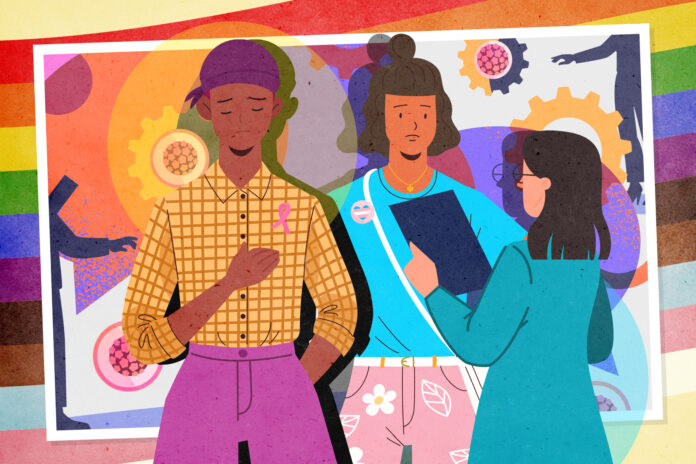5:16
Outside the margins: BIPOC and LGBTQ2 breast cancer patients rewrite the narrative
Like many young people who receive a cancer diagnosis, when 34-year-old Selene Caister went to the emergency room with terrifying and unexplained symptoms, doctors sent her home and told her to come back if the issue persisted.
The pain and bleeding she experienced when she went to the bathroom did not abate, and Caister returned to the emergency room hoping that doctors would have a different answer for her. They didn’t.
“Basically it was the same thing that happens when you call tech support and they just have no freaking clue,” Caister, now 40, told Global News. “It was literally like a shrug and a wave.”
After months of emergency room doctors running blood tests, CT scans, doing physical examinations and then sending her home, Caister was still no closer to understanding her symptoms. It took a family doctor intervening on her behalf for the hospital to take her seriously.
Armed with a letter written by her family doctor demanding that the ER admit her, Caister walked back into the hospital. She would come out days later with a cancer diagnosis.
Up until that point, doctors hadn’t even considered that her symptoms were caused by cancer.
“Nobody even looked. I nearly died,” Caister said.
She had colon cancer and had to have a portion of her colon removed in a subtotal colectomy.
“Everyone kept saying ‘Oh, you’re so young,’” Caister added. “Sure I was younger, but… I was in my mid-30s. It’s not unheard of.”
This excerpt from Kimiko Does Cancer shows a doctor assuring Kimiko that if, she gets a mastectomy, they will organize for her to get her breasts reconstructed.
Kimiko Tobimatsu
Tobimatsu ended up not needing the mastectomy in the end, but Gahagan says they have encountered this same story of doctors pushing for non-medically required breast reconstruction surgery many times during the Cancer’s Margins Project.
“Having health care providers say, ‘You’re under a lot of stress, you’ll thank us afterwards, you’ll feel better, it’ll help reduce your stress,’ etc. Well, it doesn’t for individuals who actually feel that they are not being taken seriously or not being listened to,” Gahagan said.
While the onus is partially on doctors to listen to their patients and not make gendered assumptions about their treatment, there are also structural issues within the Canadian health care system that create undue stress for LGBTQ2 cancer survivors.
“The hospital is the one place guaranteed to constantly dead-name you, and not just do it once, but do it every five minutes,” Caister says. A dead-name is the name that a transgender or non-binary person used before transitioning.
“It’s part of their requirement — to make sure they don’t give the wrong procedure to the wrong person — to constantly be asking you for your personal information,” Caister said. “So literally every time I go to a hospital, it’s like the worst experience.”
Caister needs to go to the hospital a minimum of two times a year for regular CT scans to make sure her cancer hasn’t recurred. Because she started her cancer treatment as a man, for the rest of Caister’s life she may be misgendered and dead-named by medical staff.
“They do it every time you change rooms, every time you go to a new person. ‘Give me your name, give me your birthday, give me your name, give me your birthday, give me your name, give me your birthday.’ I’m in tears by the end of this.”
For Tobimatsu, simply seeing only the male and female checkboxes on medical forms can raise alarms.
“It’s an immediate trigger for folks reading who might not fit into that category. And even for myself, I identify as a woman, but when I see that, that’s a signal to me that this organization or this medical professional doesn’t have awareness of more diverse gender identities,” she said.
Making it easier for patients to change their names and genders on medical charts and the cancer registry is not being prioritized, Gahagan says, even though it would improve the data that Canada collects about cancer patients and would make the treatment process more comfortable and appropriate.
Gahagan also noted that a number of LGBTQ2 patients forego seeking treatment due to past bad experiences with health care, leading to later diagnoses and worse health outcomes.
The institution of cancer care was not built with LGBTQ2 people in mind, and they’re slipping through the cracks because of it. In particular, trans peoples’ experiences with cancer diagnoses reveal just how broken access to gender-affirming services are, and it showcases the abysmal support that cancer survivors receive once they leave the hospital.
One thing is clear: it’s time to rewrite the narrative of what a typical cancer survivor looks like.
—Against All Odds: Young Canadians & Cancer’ is a biweekly ongoing Global News series looking at the realities young adults face when they receive a cancer diagnosis.
Examining issues like institutional and familial support, medicine and accessibility, any roadblocks as well as positive developments in the space, the series shines a light on what it’s like to deal with the life-changing disease.



